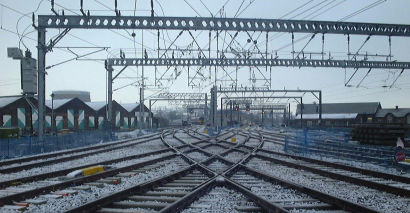NETWORK Rail is examining plans for extensive infill electrification, in addition to proposals to electrify major parts of the Great Western and Midland main lines, Railnews has learned.
Plans for new trains to replace HSTs on inter-city routes are being deferred until the Government decides whether new parts of the network should be electrified, trans-port secretary Geoff Hoon has told Parliament.
“Initial work suggests that the case for electrification appears strongest on the most heavily used parts of the Great Western main line from Paddington, and the Midland main line north of Bedford,” Mr Hoon told MPs.
“We will analyse the value for money, affordability and financing options of the electrification proposals which Network Rail will put to me shortly.”
Mr Hoon added: “Electric trains are lighter, accelerate faster, are quieter and emit less carbon dioxide. We are well advanced in procuring replacement trains for the inter-city routes but before we finalise our plans we need to decide whether new parts of the network should be electrified.”
The extent of Network Rail’s planning for electrification – prepared for the National Networks Strategy Group, chaired by transport minister Lord Andrew Adonis – emerged last month during a series of briefings given by Network Rail to industry stakeholders about its work in examining the case for new lines and further electrification.
At briefings in London, Bristol, Cardiff, Leicester, Birmingham, Manchester, York and Glasgow, Network Rail’s new lines project manager Sanjay Jaumur made clear that proposals on whether new lines should be built – and, if so, whether they should be high-speed routes – will be published in July.
The new lines programme will focus initially on a high-speed route from London via Heathrow Airport to the West Midlands – and seems already to have won government support in principle.
NR has confirmed that it will publish a report on electrification plans “in the summer” and Geoff Hoon said he will make a further statement “later this year”.
The report on electrification appears likely to embrace more extensive plans for infill schemes than have been proposed before.
The majority of in-fill electrification would be in the Manchester and Leeds areas, with the northern TransPennine route becoming electrified throughout.
The infill routes have been chosen because electrification will increase their capacity, as well as mostly providing diversionary routes for electric trains during engineering work or disruptions.
Mr Allen said consideration of electrifying two main trunk routes – Great Western to Bristol and Cardiff, and the Midland main line to Sheffield – was also being linked where possible to future strategy for diversionary routes. For example, electrifying Bedford-Bletchley was being considered, along with Bedford to Derby, Nottingham and Sheffield.
When expertise has been regained, Mr Allen said Network Rail plans to electrify 600 single-track kilometres (370 miles) a year.
Network Rail believes that a single 500-metre-long factory train could install 1.5 single-track kilometres (almost one mile) of overhead line equipment in a single eight-hour engineering possession, which would be confined to a single line so adjacent tracks could remain in use.
If the go-ahead was given to electrify the Great Western and Midland trunk routes, three factory trains would be needed in total, according to Mr Allen.
But he expected the first one would be put into use in the Greater Manchester area, where a final decision on electrification awaits the result of a feasibility study on proposals by Northern Way – an economic strategy by the three northern Regional Development Agencies – to improve capacity in and around central Manchester.
Mr Allen said that as part of the electrification review, Network Rail was also examining how, and by what means, sufficient additional power should be generated for electric train operations.
He explained that if an electrification programme goes ahead, it must be linked with industry-wide strategies for rolling stock replacement and for ‘cascades’ of existing trains.
In briefings about plans for new lines Network Rail has emphasised that, as from the full implementation of the new high-frequency timetable on WCML, it is impossible to run any additional peak-hour trains between London and Milton Keynes on the fast lines.
The only way capacity could now be increased is by lengthening trains and introducing the European Train Management System (ERTMS).
Peter Allen, Network Rail’s electrification enhancement engineer, told last month’s stakeholder briefings of plans to electrify potential routes, including:
750 V dc (third rail)
- Basingstoke-Salisbury
- Ashford-Hastings
- Uckfield line
25 kV ac (overhead)
- Felixstowe-Ely-Peterborough (ECML)-Nuneaton (WCML)
- Greater Manchester area, including to Preston and Blackpool
- Leeds/West Yorkshire area, plus Leeds-York- Scarborough and Leeds-Hull
- Darlington-Sunderland- Newcastle
- Newcastle-Hexham-Carlisle
In Scotland, electrification will be determined by Transport Scotland.
Electrification plans expand to take in more routes
4th February 2009


